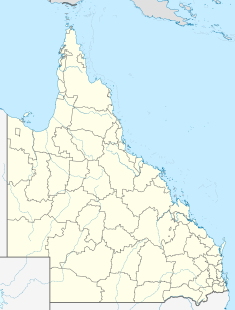Braeside Homestead
| Braeside Homestead | |
|---|---|

Braeside Homestead, 2015
|
|
| Location | Crystal Mount Road, Dalveen, Southern Downs Region, Queensland, Australia |
| Coordinates | 28°24′03″S 151°54′24″E / 28.4009°S 151.9067°ECoordinates: 28°24′03″S 151°54′24″E / 28.4009°S 151.9067°E |
| Design period | 1840s–1860s (mid-19th century) |
| Built | 1870s–1920s |
| Architectural style(s) | Classicism |
| Official name: Braeside Homestead | |
| Type | state heritage (landscape, built) |
| Designated | 23 August 2002 |
| Reference no. | 602351 |
| Significant period | 1870s-1900s (historical) 1870s, 1900s-1920s (fabric) |
| Significant components | garden/grounds, tennis court, kitchen/kitchen house, trees/plantings, wall/s – retaining, residential accommodation – main house, tower – observation/lookout, chimney/chimney stack, carriage way/drive, terracing, out building/s |
Braeside Homestead is a heritage-listed homestead at Crystal Mount Road, Dalveen, Southern Downs Region, Queensland, Australia. It was built from 1870s to 1920s. It was added to the Queensland Heritage Register on 23 August 2002.
The block on which Braeside Homestead is situated was taken up in 1869, during the opening of large tracts of Rosenthal run to selection in the late 1860s and early 1870s. The homestead itself was established in the mid-1870s. From 1879 to 1901 the property was developed as a model stud farm by Queensland pastoralist, politician and businessman William Allan. It is not certain who named the property, but by 1887 Braeside was identified in the local electoral roll as both the grazing property and a locality.
In the earliest years of non-indigenous settlement on the southern Darling Downs, Braeside was included within the Leslie brothers' mid-1840 ambit claim for Tulburra run, and from c. 1841 was part of the North British Australasian Investment Co.'s Rosenthal run, excised from Tulburra.
Under the provisions of the Alienation of Crown Lands Act of 1868, James Adam Veitch of Warwick selected two blocks along Turner Creek from Rosenthal Run in 1869. These comprised selection 286 (containing the site of Braeside Homestead – 1280 acres of first-class pastoral land and 1280 acres of second-class pastoral land) selected on 25 August 1869 and adjacent selection 295 (320 acres of first-class pastoral land and 320 acres of second-class pastoral land) selected on 15 September 1869 – making a total of 3290 acres. Under the conditions of selection, Veitch had to pay an annual rental of £96 per annum on selection 286 for a period of ten years, commencing 1 July 1869, and had to make improvements. Once these conditions were satisfied, he could apply for freehold title.
The Darling Downs Bailiff for Crown Lands first inspected selection 286 on 16 December 1875, to ascertain proof of the fulfilment of the conditions of selection. At this time boundary rider Henry Steel had been in residence on the block from 1 January 1870, acting as bailiff for JA Veitch, "sheep overseer" of Glengallan. The property was stocked with 1000 sheep and 224 head of cattle, property of the selector. Improvements consisted mainly of fencing and sheep yards, and there was a two-roomed slab hut with a bark roof, chimney, verandah, and "bush furniture", which was the residence of Steel and his wife. The inspector's report and neighbours' declarations satisfied WC Hume, the Darling Downs Commissioner of Crown Lands, who in February 1876 issued Veitch with a certificate of fulfilment of the conditions of selection. The next month Veitch signed over his interest in the leases of selections 286 and 295 to South Toolburra grazier Bertie Chiverton Parr, who immediately paid off the outstanding debt and gained freehold title in July 1876. Parr likely named the property, and also appears to have acquired a number of adjacent selections which became part of Braeside.
...
Wikipedia


